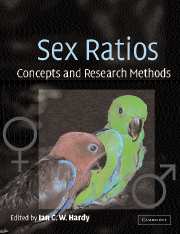Book contents
- Frontmatter
- Contents
- List of contributors
- Preface and acknowledgements
- Part 1 Sex ratio theory
- Part 2 Statistical analysis of sex ratio data
- Part 3 Genetics of sex ratio and sex determination
- Part 4 Animal sex ratios under different life-histories
- Chapter 10 Sex ratios of parasitic Hymenoptera with unusual life-histories
- Chapter 11 Sex ratio control in arrhenotokous and pseudo-arrhenotokous mites
- Chapter 12 Aphid sex ratios
- Chapter 13 Sex ratios in birds and mammals: can the hypotheses be disentangled?
- Chapter 14 Human sex ratios: adaptations and mechanisms, problems and prospects
- Part 5 Sex ratios in plants and protozoa
- Part 6 Applications of sex ratios
- Index
- References
Chapter 12 - Aphid sex ratios
Published online by Cambridge University Press: 06 August 2009
- Frontmatter
- Contents
- List of contributors
- Preface and acknowledgements
- Part 1 Sex ratio theory
- Part 2 Statistical analysis of sex ratio data
- Part 3 Genetics of sex ratio and sex determination
- Part 4 Animal sex ratios under different life-histories
- Chapter 10 Sex ratios of parasitic Hymenoptera with unusual life-histories
- Chapter 11 Sex ratio control in arrhenotokous and pseudo-arrhenotokous mites
- Chapter 12 Aphid sex ratios
- Chapter 13 Sex ratios in birds and mammals: can the hypotheses be disentangled?
- Chapter 14 Human sex ratios: adaptations and mechanisms, problems and prospects
- Part 5 Sex ratios in plants and protozoa
- Part 6 Applications of sex ratios
- Index
- References
Summary
Summary
Aphids produce males and females by a parthenogenetic process that gives the mother proximate control of sex allocation. Sex is an infrequent, usually annual, punctuation in a sequence of asexual generations. The aphid genome, initiated in the fertilized egg, is replicated in a sequence of bodies that make up the aphid clone and which can be thought of as a disaggregated hermaphrodite: selection acts at the clonal level to produce an optimal allocation in sperm and ova. Two crucial factors influencing sex allocation are the degree of within-clone mating and the timing by the clone of investment in males and mating females. Extreme sex ratios are very common in aphids, to an extent that is probably unique amongst diploid organisms. The aphids, unshackled from the constraints imposed by meiosis on sex determination, therefore provide an excellent opportunity for those interested in the evolutionary biology of sex allocation.
Introduction
Aphids are of special importance to evolutionary biologists because they are a diplodiploid group in which the mother clearly has proximate control of the sex of her offspring. They thus provide a genetic system other than haplodiploidy in which the default allocation ratio is not 0.5 (proportion investment in males, i.e. males/(males+females)). My aim in this chapter is to review current knowledge of aphid sex ratios, to provide a brief, accessible account of the relevant biology of these animals, and to highlight aphid groups and specific ideas that would be especially fruitful to study.
- Type
- Chapter
- Information
- Sex RatiosConcepts and Research Methods, pp. 254 - 265Publisher: Cambridge University PressPrint publication year: 2002
References
- 7
- Cited by



